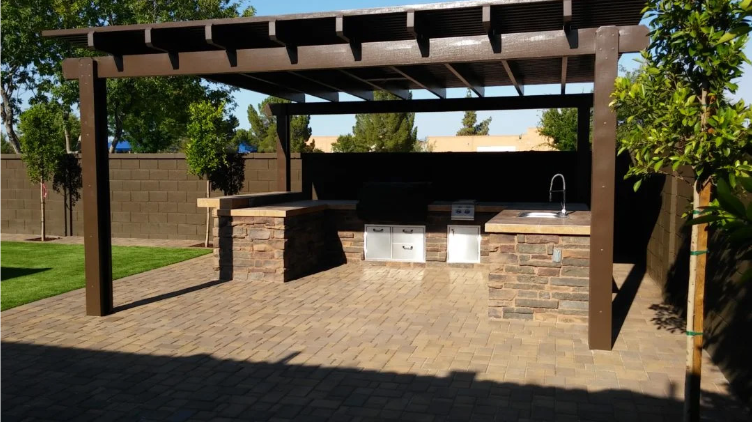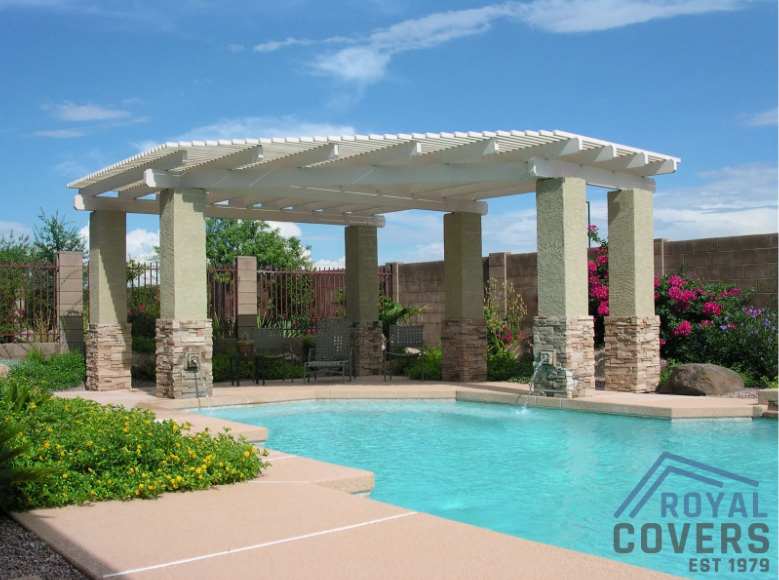Freestanding pergolas are a unique and elegant option for those looking to cover a specific area in their backyard. With numerous design options available, more people than ever are thinking about investing in this beautiful and efficient structure. However, many worry about the stability of the structure and its support. That’s why, in this article, we want to give you a detailed guide on how to stabilize a freestanding pergola and the process behind it.
By elaborating on the reasons that may cause a wobbly pergola, you’ll get a better understanding of what mistakes you should prevent to avoid this issue. Furthermore, with our experience dating back to 1979, we’ll give you some tips and tricks on quickly fixing this issue. Continue reading to discover how to stop pergola from swaying in a few simple steps!

Source: royalcovers.com
How to Stabilize a Freestanding Pergola
What are the steps to properly stabilize a freestanding pergola? Here are three common fixes you can try out:
- Replace damaged sections
- Properly anchoring the structure
- Reinforce the existing structure
Replace damaged sections
If choosing the wrong building materials is the reason for a wobbly pergola, we advise replacing the damaged sections of the structure. Since wood is the most commonly used material, we recommend inspecting the whole structure and only changing those parts where there’s visible decay. Furthermore, you can check the fittings for signs of rust to ensure each part is sturdy.
When replacing damaged sections of the pergola, we must warn our customers to never do it alone. Even the slightest miscalculation can bring the whole structure down and cause substantial damage. Thus, we always recommend contacting us and letting our professional team make the needed replacements.
Properly anchoring the structure
Those who have concluded that the pergola’s stability is compromised by the improper anchors should focus on properly anchoring the structure. The first step in this process is to dig around the posts with specialized tools to reach the anchors. Then, concrete is applied to the base to keep the structure sturdy. After the concrete has dried, the holes are covered, and the pergola is stabilized.
While some may be tempted to try this themselves, we advise that you contact our professional team to ensure your safety. Besides having the specialized tools required for the process, we’ll also get it right on the first try without wasting time and materials.
Reinforce the existing structure
Lastly, if the reasons behind the wobbly pergola are uneven ground and poor assembly, we recommend reinforcing the existing structure. While the minimal solution is to tighten a few screws, this process will vary depending on the complexity of the problem. If the issue lies in the missing crossbeams, additional beams must be added to the structure. Doing so will ensure the weight is distributed evenly and that the posts are held firmly in place.
If you’re dealing with a larger pergola area, we may also recommend adding corbels and brackets for additional support. Not only will this improve the integrity of the structure, but it will also prevent any cave-ins.
Reasons for a Wobbly Pergola
A wobbly pergola is something that everyone wants to avoid. Not only does it take away from the aesthetic appeal, but it may also pose a safety risk. Since these structures aren’t attached to buildings or walls, they must stand firmly on at least four posts that usually require concrete footings.
So, if you’re looking for a fantastic solid top pergola, we recommend you check out what we at Royal Covers offer! Not only do we combine the right choice of products with our wealth of experience, but we also offer a workmanship guarantee on every project. This way, we can support all our customers if any modifications are desired after the finalization of the project.
As low-maintenance patio cover specialists, we’ve encountered several key factors that may cause a wobbly pergola. If you’re wondering how to stop pergola from swaying, here are the main issues you should watch out for:
- Uneven ground
- Improper anchors
- Wrong building materials
- Poor assembly
Uneven ground
The main reason why a freestanding pergola may need stabilization is because it’s placed on uneven ground. Most of our clients who have taken upon assembling a pergola as a DIY project come across this issue due to poor planning. Even though it’s possible to build a pergola on sloped terrain, it can cause unexpected complications down the line. Thus, we always advise our customers to level the site before construction begins and let a professional do the job.
Improper anchors
Many people who plan on investing in a pergola aren’t informed about the process behind its assembly. One of the most common questions we’ve had is does a freestanding pergola need to be anchored. As mentioned, since this structure isn’t connected to a wall or building, properly anchoring it to the ground is a must. Thus, one of the common reasons why someone may experience a wobbly pergola is due to improper anchors.
The main reason why this issue is considered to be one of the most difficult to detect is because the anchors are placed underground. Without a clear visual of these parts, identifying the problem usually involves special digging tools to assess the integrity.
We’ve noticed that this issue most commonly appears in locations with high winds that impact the structure over time. Thus, if one of our clients experiences an unstable pergola due to wind-related damage, it’s essential to check the anchors to prevent any future damage to the structure.
Wrong building materials
Choosing the wrong building materials is another common cause of wobbly pergolas. If a client chooses a material unsuitable for outdoor use, the effect of the natural elements may cause it to degrade over time. Thus, the structure will lose stability if the problem isn’t regularly addressed.
The most common materials for building pergolas are aluminum, metal, wood, and vinyl. We always recommend our clients to choose the most suitable material based on their location while also being mindful of the weather conditions.
For example, while wood is one of our most popular options, it can easily get damaged due to wind and UV exposure. Besides showing obvious signs of damage, such as cracking, peeling, chipping, and splitting, it also affects the structure’s overall integrity.
Poor assembly
The last reason that may cause destabilization in a freestanding pergola is poor assembly. Remember that even the smallest element is essential to the pergola’s support. Luckily, this is one of the easiest issues to detect and fix.
Poorly securing the fasteners or brackets can lead to loose beams that are likely to move and make the structure unsafe.
The second common assembly mistake is the lack of crossbeams. When the structure is missing these crucial supports, it can lead to the top of the pergola moving diagonally when shifting.

Source: royalcovers.com
Conclusion
After discovering how to stabilize a freestanding pergola, we want to emphasize the importance of hiring a professional service for the most desirable outcome. Since these structures are fairly large, failing to implement any changes safely can be dangerous.
Whether the issue is caused by uneven ground, improper anchors, poor assembly, or unsuitable materials, it takes an experienced team to find the best solution. So, whenever you notice that your pergola’s structure is wobbly, contact our team at Royal Covers, and we’ll deliver premium-quality results!
